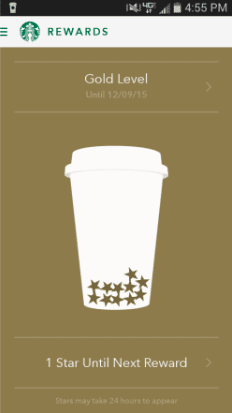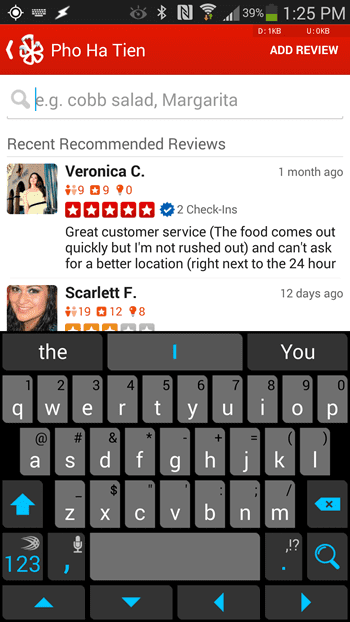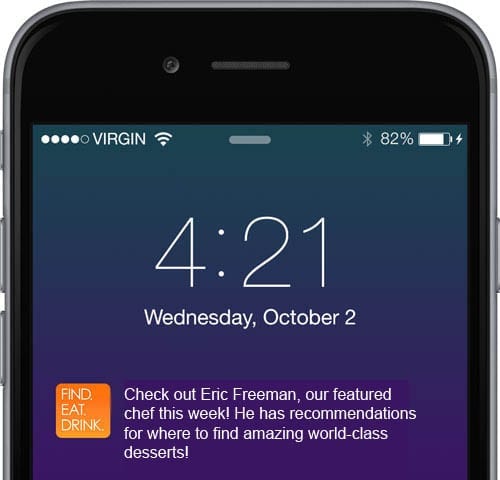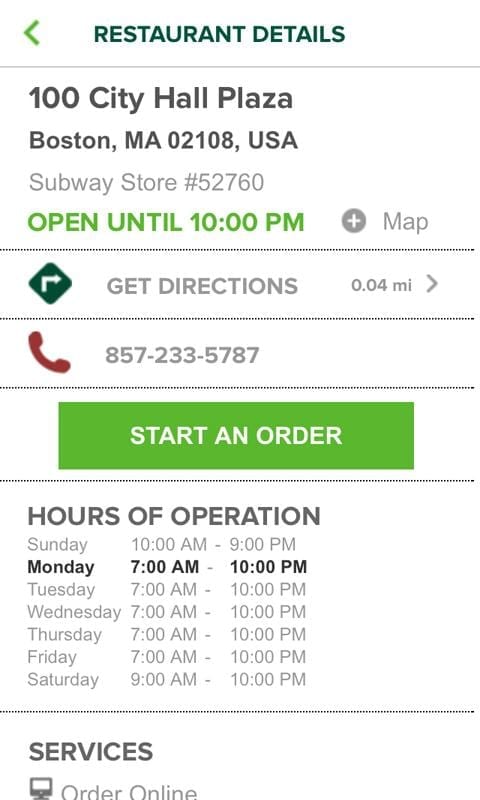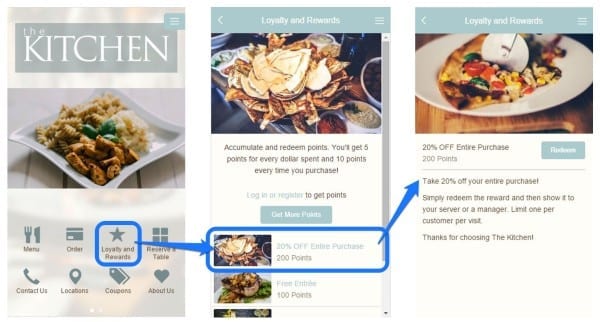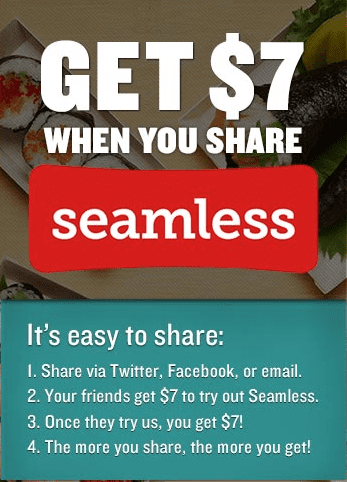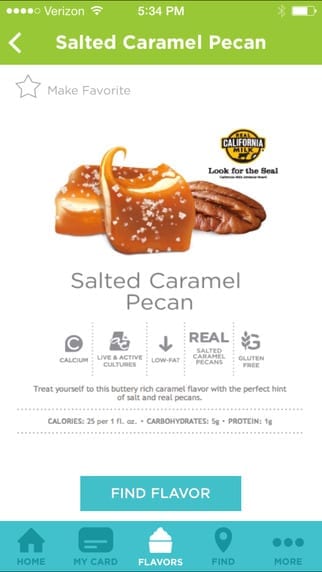14 Reasons Why Your Restaurant Needs a Useful Mobile App

There’s a lot of preachy advice out there on how important it is to develop a mobile app and make sure you have a strong mobile presence.
But the vast majority of that advice is written by app development companies with no real concern over how well your business eventually does as a result of your marketing efforts… they just want to scare you into signing up for their services by throwing out scary-sounding numbers that may or may not be backed up by actual, published facts.
But when you consider that 60% of local searches on mobile convert into buying customers within the hour, and the fact that Starbucks (a company notorious for leading the trends in the food and beverage industry) conducted 16% of their monetary transactions over their app alone.
Which means that even though someone has to be in a physical Starbucks location to buy one of their drinks, $1.6 billion of a $10 billion revenue was all done via mobile.
Create a Mobile App for FREE with BuildFire
I don’t know about you, but I don’t think $1.6 billion is anything to cough at.
So it’s clear that the ideal of mobile for restaurants is an upcoming trend… but the real question is, is it worth the investment for your business?
We’ve got 14 data points to present to you… all complete with real-life examples to help you do the math on the potential revenue and customers you’re missing out on so you can make that decision to invest in a mobile app for your restaurant.
1. Location-Based Deals
I think by now we’re all familiar with Apple’s iBeacon.
For those who aren’t, it’s basically a small device you can set up in and around your location to send push notifications and deals to people in your location’s physical proximity to lure them into your restaurant during meal time.
Beyond that, you can also rely on a person’s GPS settings to tell you where they are and send out relevant deal information if you’ve got more than one location.
The Bookatable app, for example, started using beacon-based technology in 119 of their participating London restaurants, sending push notifications to users of the app who walked within a 50-meter radius of one of the restaurants.
By doing so, they were able to jump out at users of the app who might be looking for a bite to eat, but weren’t sure exactly where to go. By helping totally eliminate or expedite that decision-making process, Bookatable was able to get more visitors into their participating restaurants, boosting their business.
Bookatable offers location-based deals using beacon technology.
But beyond sending push notifications about deals to prompt more purchases, you can make sure people know where they’re going, find the right place, and don’t get sidetracked into another restaurant while they’re walking that last stretch to your restaurant’s front door.
2. Loyalty & Referral Programs
On Black Friday 2015, a pizza joint called Pizza Ranch ran a promotion that gave their customers double points for coming in and buying from them that day, which generated 67.6% more business for that day than they normally do.
It was such a successful and low-cost strategy to employ that their ROI was 780% on the money and time they invested.
One of the biggest reasons this works is the fact that mobile-based loyalty programs are far more personal than the ones that involve a simple punch-card being handed out to every customer who buys a drink.
The data and the interaction is on their phone, a device that hardly ever leaves their side.
Plus, you can insure continued use of your loyalty program and more purchases to contribute towards final goals by sending push notifications reminding your loyal customers how close they are or suggesting for them to come in for a meal or a drink that would put them over the edge points-wise for their prize.
But don’t just think that loyalty programs are solely about the free stuff.
According to research, 65% of restaurant customers would be willing to download your restaurant’s app if you promised them exclusive offers and deals from time to time, and a whopping 80% of those people would proactively return to your restaurant to reap the benefits… even if it meant they’d have to keep buying a few times before they got anything.
Broken down, that’s 52% of ALL restaurant-goers (which in the US, is just about everyone—so you’ve got over half of the population) willing to download your app and proactively return to your restaurant to redeem deals and loyalty promotions.
Effective rewards programs don’t have to be elaborate or difficult… as you can see with this screenshot from Starbucks.
Ka-ching.
Beyond that, you can incentivize your customers to refer their friends and family to your restaurant by offering them points or credit towards their bill based on how many people they refer to your location and come in to make a purchase.
Fronto Lock Screen makes referrals for their app easy and incentivized.
3. Easier Internal Order Fulfillment
Beyond making more money, mobile apps (especially the ordering options for pickup or delivery) make it easier to fulfill your orders.
Instead of having someone constantly man the phones and try to understand what the person on the other end is saying and relying on their handwriting to accurately convey what needs to be done to the cooks, the people responsible for filling orders can see plain and clear exactly what needs to be made, along with any special requirements given by the customer.
And with in-app payment, there’s one less thing your front desk staff or delivery guys have to worry about.
For example, if someone has to call in to place a delivery order, there’s a constant back and forth between them and your receptionist to write down the order, double-check it, write down and double-check the address, and if they pay by credit card, the communication to make sure every single digit is correct.
Even if you only pay minimum wage (currently $7.25 per hour) for that position, it’s labor you could completely do without by having customers place their order, write out special instructions (like no pickles) directly into a comment section, and have them confirm their saved address directly within the app itself. It’s quicker & more painless for everyone involved… and it saves you around $2,000 per month.
Taco Bell lets customer customize their orders from directly within their app without having to take the time to speak with someone over the phone about their preferences. This also makes it easier for the cooks because they can plainly see if any ingredients need to be tweaked.
4. Increased Sales Amongst Millennials
Arguably, you’d increase your sales amongst all demographics, but the millennial market is quite strong in their preferences here.
According to Food Tech Connect, 98% of 18 to 34 year-olds who’ve paid a bill via mobile would like to do so again. But beyond simply paying, 35% like to place their orders on smartphone or tablet, and 40% actually prefer a mobile payment over other options, especially for restaurants offering quicker service.
When possible, millennials prefer to pay for their order directly within the app itself.
According to Restaurant Marketing Labs, each millennial spends an average of $174 per month on eating out. ($21 more than the average non-millennial.) So by catering to their preferences of offering mobile payments, you can get a larger chunk of their monthly spending power into your business revenue.
5. More Seats Filled
In case it hadn’t been clear already, it was obvious that something was up with online means of making restaurant reservations when travel companies began buying out restaurant reservation operations… with some of the deals worth billions of dollars.
Knowing that you’ll have a table at one of your favorite places when you’re traveling in an unknown city or just trying to plan a nice night out is really important for hungry eaters who don’t like to wait.
Estimates on exactly how many restaurant reservations are made on a monthly basis via mobile vary greatly… but it seems safe to say that it’s at least in the 100,000 range.
Plus, by allowing your customers to just use your app to make a reservation without the worry of having to call in, catch the host or hostess by the phone at the right time, and compete with the roar of a typical restaurant’s background noise, you make the process of making a reservation pleasant.
Here’s a basic screen we use to help our restaurant customers take reservations via their mobile app. Click to call is always an option, but so is using a third party reservation service.
So, if your restaurant brings in $5,500 on a Friday night and your app helps increase those reservations by 10%, that’s an additional $550 in revenue just for that night. Across a year, even if only done on Fridays, that’s another $26,400.
6. Better On-Site Service
Though creating a mobile app for your restaurant is mostly about catering to the customer and their experience, using one can also improve on-site service… and the reviews that reflect it.
Here’s an example of how:
Let’s say you run a sandwich shop that relies heavily on carryout orders from surrounding businesses for the lunch hour.
Your shop is rather small and doesn’t have much standing room in the front, which is slammed with sweaty, hungry people from 11:45 to 1:30 every single day… all who either just want to place an order and leave, or some who just want to sit down at a booth.
Mobile ordering before they show up in your doorway sweaty, hungry, and confused can help clear out a lot of that congestion.
Instead of waiting for in-shop fulfillment, your staff can see a new order as soon as it comes in, put it together, price it, and prepare it for immediate carry out. Your carry out customers only spend a few moments in your shop and are happily on their way, clearing out your small standing area for other carry out customers and your traditional customers waiting for seating.
Plus, it makes order fulfillment a lot faster.
According to food ordering app GrubHub, fulfilling an order that takes place via a phone conversation takes two minutes to fulfill, while one of their mobile orders only takes 45 seconds… resulting in a much quicker turnaround and streamlined pickup experience. (Plus the fact that the host can be fully attentive to people coming in and doesn’t have to worry about minute-long phone conversations that keep people waiting.
7. Social Sharing
One of the best parts of integrating a mobile app into your restaurant’s other online profiles is the ability to collect more reviews the instant someone happily leaves.
Get Started With BuildFire Today!
Pick a template to start designing the app yourself, or let our professional design team build it for you.
- Mobile app development for iOS & Android
- No coding required
- 150+ pre-built features
- Unlimited customization
- 14 day free trial
Particularly if you run either reservations, ordering, or payments through your mobile app (or all three), you can set a timer for after one of those transactions is completed to ask your patrons to review your app on one of your online profiles or share their experience on social media. (Possibly for more loyalty reward points… are you seeing how all this works together now?)
Getting your customers to share positive experiences on social media is a great way to advance the word of mouth and social proof around your business… boosting your reputation in the mind of the public, leading to increased business over time.
The text next to these social sharing buttons says, “Share this deal with friends and family and everyone receives a lower price.”
8. More & Better Reviews on Ranking Sites that Matter
And beyond asking people for social shares when they leave and are satisfied with your restaurant experience, you can also send push notifications asking them to leave a review… directing them to the ranking and review site that matters most to you at the moment.
For example, if you know you’ve only got three reviews on Yelp and you’re losing business because of it, a couple weeks of satisfied mobile customers leaving happy reviews can turn that around in no time.
Plugins like Appirater for iOS let you ask for app-based reviews when someone is ending a session.
And though such a plugin doesn’t exactly fit the purpose of this point, you can easily see how you could prompt a customer to rate their experience in your restaurant in connection to a third party site like Yelp after their dining experience is over and they’ve completed the function of paying their bill.
And rather than worrying about building the functionality directly into your app, you could simply prompt a button to show up that would direct them directly to the Yelp page for your restaurant where they can start typing their review.
9. Better ROI on Specials You Offer
Push notifications can easily solve eating out decisions.
If it’s Friday or Saturday, you can plant the idea of eating in your restaurant that night as early as lunch time. For example, if you’re running a special on some popular dinner plates, you can send a push notification to your app users to let them know. When the time for choosing a restaurant comes, they’ll already be thinking about eating your food and validating it with the fact that they can save money on it.
For example, a restaurant called Tacolicious in San Francisco started sending out push notifications about their Margarita Monday happy hour.
And according to their owner, that was all they needed to fill the house on a Monday night… a night when most people don’t usually go out for a drink.
“Our Margarita Monday happy hour push notifications filled the house!” he exclaimed.
This push notification example from Leanplum is a perfect example of a simple push notification you can send to your users to boost business.
10. Easy Menu Access
According to research conducted by the firm Chadwick Martin Bailey, 62% percent of customers are less likely to stop into your restaurant if they can’t easily see your menu on their mobile device.
And instead of relying on funny renderings of mobile-responsive web pages, you can make sure your menu is easy to access, front and center, in your app.
Steak N Shake makes their menu a main navigation item in the bottom right corner. This ensures that users can find it instantly without feeling like they have to dig for the information.
11. Click to Call
Beyond building ordering, reservations, and delivery directly into your app’s functionality, you can also add a click to call button for customers with questions they’d like to have answered about the menu, reservation times, or location.
It seems like a small detail, but it cuts down on the customers need to first look up your phone number in Google, note it down somewhere, and then call you to get their question answered.
With this feature, it’s instant.
The line with the phone icon and the store’s number is a click to call link, meaning that all a user has to do is tap on it to start a call to that branch.
According to research commissioned by Google, 70% of people who search on mobile use click to call, so when you put that feature directly in your app, there’s no need for users to do a Google search for that number and stumble across a better deal from a competitor.
12. Higher Coupon Redemption
Coupons have historically been one of the most popular ways of boosting business, and today is no different.
The first coupon went out in 1887, 129 years ago, when a Coca-Cola executive created hand-written notes for a free bottle of Coca-Cola, which then cost five cents.
The idea took hold, and Coca-Cola served 8.5 million free drinks this way between 1894 and 1913, and by 1895, it was sold in every US state.
Coupons work.
The only thing that’s changed, however, is most people don’t read a physical, daily newspaper where coupons have been traditionally printed, so you’ve got to get a little more creative with coupon delivery.
And when you deliver your coupons via mobile, you’re not only getting more people to notice it, but you’re increasing their likelihood of actually coming into your restaurant and redeeming it since they don’t have to bother with carrying around tiny pieces of paper.
Here is how integrating coupons into your mobile app can keep customers happy and saving money at your restaurant without worrying about carrying anything extra around. All they have to do is show the coupon to the waiter. (source)
When Carl’s Jr. decided to send out mobile coupons for their deals (they used SMS instead of app notifications), they had 19% of the coupon recipients come in and redeem them… and for every dollar they spent on the campaign, they made $14 back.
13. More Referrals
In line with the ideas of creating a rewards program and the idea of prompting reviews and social shares, developing a mobile app as a tool for your restaurant’s marketing campaign can boost referrals when you pair these two concepts.
If you have a happy customer participating in your rewards program, you can promise them even more rewards points for sending out SMS or social referrals to their friends.
According to Referrizer, 83% of your customers would be willing to refer your restaurant to your friends, but less than 29% actually do.
By offering incentives to your loyal customers for making referrals and offering a deal for first-time visitors, you can both increase your client base and customer retention.
This restaurant ordering app offers a $7 incentive to make referrals. (source)
14. Photo Display to Entice
Much in the same way you’d use images of your food on your website and in your menu to prompt desire for the plates you’re trying to sell more of, you can insert enticing photos of your food on your app.
Seeing an image of food that’s “ready” to eat taps into a core, animal desire to keep ourselves nourished and fed… and the better it looks (and the more hungry we are), the more likely we are to act on it.
Pizza Hut displays a partially-eaten pizza front and center on their app’s main screen. So even if you weren’t that hungry when you opened the app, you are now.
Yogurtland even does this with their flavors. Though they don’t serve food that looks exactly like this, they serve this flavor. A picture like this is much more enticing than simply seeing the words “Salted Caramel Pecan” in a list of 30 other flavors, isn’t it?
Where possible, try to add photos of your product (food) in context (people eating it). Showing the food “in use” adds action, interest, and helps app users imagine themselves happy and in the exact same situation.
Geez, is anyone else hungry now?
Conclusion
I’ve got a secret for you.
Even though it feels like app marketing and app development is being preached to small businesses and restaurants like crazy, 95% of restaurants didn’t have an app a year ago.
So this means if you do decide to develop one, you’ve got the potential to be one of the top 5% of restaurants in your area. Which is a pretty big deal, if you think about it.
The reason, we think, is because while the idea to develop an app is a good idea, the work behind making it a reality is too much for busy restaurant owners to handle.
Which is why we’ve set up a system where you can set up a basic app for your restaurant that will get you a lot of the benefits we’ve discussed above. The creation is free, won’t take even the slowest person more than half an hour, and you don’t start paying for it until you’re ready to use it.
Go ahead, check it out.

